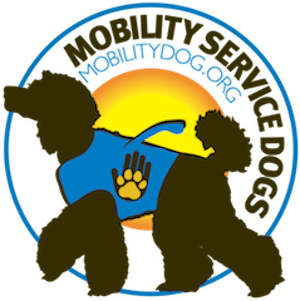Preventing Injury in Your Athletic Dog
Poodles Taking a Rest During a Hike (Courtesy: MobilityDog.org)
Dogs are athletic marvels, with the way they run, jump, catch and fetch. Hardly surprising, then, that formal athletics contest for canines are increasing in popularity. For example, agility games have become one of the most popular and recognizable canine sports, with more than one million entries into American Kennel Club agility programs each year.
Like People, Dogs Can Be Injured
Canine athletic endeavors like agility contests bring risks similar to those incurred by human athletes engaged in strenuous sports. The athletic talents dogs need to excel at canine sports fall into three essential categories:
Speed: Accelerating and moving from point to point quickly.
Endurance: Sustaining speed for an extended time.
Agility, Coordination, and Practice: Sensing body position and executing complex body movements in concert to avoid wasted energy and loss of momentum.
Unlike humans, however, there is scant research on the injury risks to dogs' sports participation and how those risks can be reduced. At this point, dog owners and trainers whose canines are athletes must rely on common sense and findings from research on human athletes to guide their dog training and injury prevention.
Pack of Five Poodles Resting on the Beach (Courtesy: MobilityDog.org)
Speed
Just like people participating in sports requiring quick bursts of speed, dogs may suffer stress fractures and muscle or tendon injuries. As the muscles needed for explosive movement increase in size and strength, the risks of these injuries increase. Humans take precautions to lower the risk of injury by stretching before exertion, varying the sports they undertake, changing running surfaces (for instance, not always running on asphalt or concrete) and increasing training time and effort over time. These same strategies also make sense for canine athletes.
Endurance
Sled dogs are the paradigm of canine endurance. Training a sled-pulling dog, like training a human distance runner, requires:
Extended sessions of low-to-moderate aerobic exertion (60 percent of maximum aerobic capacity for about 70 percent of training time).
Interspersed with shorter sessions at higher exertion levels (approximately 20 percent) and
Even shorter, intense segments (10 percent of training).
Training may also incorporate pulling a sled or sled-like device to build muscle strength. Bones, muscles, and tendons grow stronger with this kind of periodized training, which helps prevent (or at least delay) osteoarthritis.
Agility, Coordination and practice
These skills move the trainer’s attention away from foundational fitness and conditioning and toward sport-specific techniques. To become proficient, a dog must consistently practice the particular skills required by each sport.
Obstacle course running calls for repeated trips through a practice course.
Frisbee catching, broad jumping, and tunnel running also require effort in each skill area.
Dogs love these activities, so letting an enthusiastic dog overdo it can result in a significant injury risk. (Source: DVM360.com) Researchers of human athletes estimate that 60 percent of injuries in runners result from erratically scheduled training, overtraining, and training too frequently. Dogs are likely subject to the same problems.
Poodle Resting after Playing (Courtesy: MobilityDog.org)
Early Conditioning … How Much and How Intense?
On the one hand, beginning early to raise an athletic dog is appealing. Puppies are naturally hyperenergetic, so why not channel that energy into sports training? Perhaps, but on the other hand, beginning conditioning too early can result in trauma to a dog’s growth plates.
Growth plates are soft areas located at the ends of the long bones in puppies and young dogs. Over time, they fill with cells that make a puppy’s bones longer and denser. Depending on size and breed, puppies need between nine and 18 months for growth plate closure to occur.
According to one guideline, puppies should get about five minutes of exercise per month of age (up to twice a day) until they are fully grown. The five-minute rule seeks to prevent damage to growth plates while still providing the pup with an amount of exercise suitable for his or her age.
As any human athlete can attest, avoiding injury altogether is much better than investing time and effort in healing and rehabilitating a compromised body part. The same goes for canine athletes. As the coaches and trainers of our canines, humans are responsible for ensuring injury prevention (along with proper nutrition and plenty of recovery time) is part of the regime in developing our sporty dogs.



